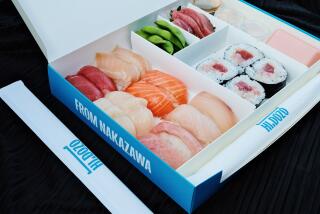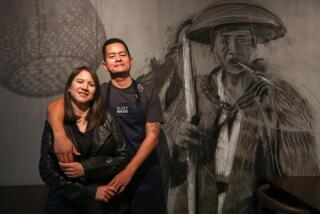U.S. Feasts on Japan’s New Tastes
TOKYO — Maruman, an ordinary supermarket in a nondescript neighborhood, hardly seems the staging ground for a Japanese food revolution.
But inside, shopper Teiko Sato is about to buy American beef for the first time after hearing that foreign meat is cheap and tasty.
Maruman manager Toshiyuki Furuichi is displaying pasta, sliced peaches and orange marmalade developed in a deal with Albertson’s supermarkets that undersells Japanese brands by 30% or more.
And over in the tidy produce section, a sign touts California broccoli from Salinas--”It’s delicious for salad and tempura!”--at 90 cents a head, one-third cheaper than its Japanese counterpart. Such a deal, and Japanese shoppers at his store are snapping up the bargains: They’re buying more than 200 bunches a day, compared with five or so of Japanese broccoli, Furuichi said.
Customers like Sato, managers like Furuichi and products like California broccoli are transforming the face of the country’s gargantuan food industry--throwing open the world’s second most lucrative food market to everything from American beef to Friskies pet food and Velveeta cheese.
Driving the change is a serendipitous combination of factors. Deregulation is opening Japan’s traditionally protected markets. A strong yen is making food imports cheaper. Japanese farmers are aging and quitting, decreasing domestic food production. Consumers are opening their palates to more foreign food. And technological advances can now delay the ripening process as fruits and vegetables make their way across the Pacific.
U.S. producers also are trying harder, demonstrating a greater willingness to grow products or alter packaging and recipes to fit the Japanese taste, analysts say.
And a five-year recession has crimped consumer pocketbooks, emboldening supermarkets to challenge traditional distribution systems--and old patterns of price-setting--in a heated scramble for inexpensive, quality goods.
Japan’s high food prices have been caused in part by a system that favored producers and manufacturers, who have traditionally set prices and punished retailers trying to discount by cutting off shipments. But such practices are coming under attack by increasingly independent retailers.
“Every supermarket is now fighting to find manufacturers who can provide quality goods at decent prices,” Furuichi said. “But Japanese manufacturers won’t discount even if you ask for it, so in order to buy cheap we have to go overseas.”
And they are. For all the grumbling about trade barriers by American growers of apples, rice and other farm goods, U.S. exports to Japan of consumer-oriented agricultural products--generally, goods found in supermarkets-- swelled to $5.2 billion in 1995 from $2.9 billion in 1989, according to U.S. government figures.
*
California, boasting the world’s most diversified agricultural economy, is reaping the biggest bonanza.
Japan already is California’s top export market, buying $2.7 billion of agricultural products annually.
State officials expect that amount to explode. In the Pacific Rim region overall, growth in U.S. agricultural exports is projected to outpace the rest of the world 2 to 1, reaching $14 billion in the next six years, officials say.
Californians “have had such a good market domestically that people haven’t had to look beyond the borders,” said Ann M. Veneman, state secretary of food and agriculture, during a trade mission to Tokyo and other Asian markets earlier this year. “But now we have a relatively stable market, and we’re looking at the Pacific Rim as the biggest potential export market.”
California farmers, for instance, are growing everything from cherries to pumpkins specifically for the Japanese market, which still generally requires uniform sizes, unblemished skins and other attractive characteristics. That marks a change from the past practice of trying to dump excess production overseas, Veneman said.
Officials say Japan’s fresh produce industry is particularly tantalizing, with sales of imported vegetables projected to soar to $11 billion over the next decade from $1 billion in 1993 as Japanese farmers--now an average age of 64--retire.
“It is an article of faith among Japanese leaders in the fresh fruit and vegetable industry that the Japanese fresh-produce sector is on the verge of a cataclysmic fall in production,” according to a confidential U.S. government report.
The result will be an “unprecedented” import demand and “tremendous opportunity to produce exporters around the world,” the report said.
Nowhere are the trends more evident than in the beef market. A landmark beef liberalization pact, hammered out by U.S. and Japanese negotiators in 1989, replaced quotas with gradually diminishing tariffs. Those tariffs--now at 46.2%--have dropped by half since 1991 and are scheduled to continue declining through 2000.
As a result, imported beef, half of it American, has flooded the market, lowering prices and turning what used to be a rare luxury into daily dinner fare.
California beef giant Harris Ranch says it ships 17% of its production to Japan.
“Beef used to be regarded as gold, but now it’s come down to copper,” said Takayuki Miyashita, head of the Komoro Cattle Farmers Assn. in Japan’s Nagano prefecture, or state, northwest of Tokyo.
The liberalization has been deadly for Miyashita and other cattle farmers who gathered in boots and baseball caps to auction off their livestock at a recent cattle fair.
As the auctioneer rattled off the bids in a staccato voice, it was clear that the black-and-white Holsteins and fatty black Wagyu Japanese steers do not fetch nearly the price they used to. One farmer pointed to a 6-month-old Holstein in the center of the auction block: Before liberalization, he said, it could have sold for $1,800; it went for $680.
The plunging prices are driving scores of cattle farmers out of business.
In Nagano alone, Miyashita said, cattle farmers have dwindled to 350, from 600 before liberalization--and many more would quit if they did not have to worry about repaying debt. Many had borrowed heavily to enter what once was a lucrative field and got caught unawares when liberalization drove down anticipated profits, Miyashita said.
*
Hisao Takatsuka, 65, is a typical example.
A cattle rancher for 47 years, he owned 200 head in the late 1980s. But after liberalization, his income dropped by half, forcing him to sell 150 cows and lay off two workers.
As he warmed himself before a gas stove at the Komoro cattle fair, Takatsuka said he is just marking time until he no longer can continue the demanding physical work. His son, an engineer, does not want to take over the ranch, and Takatsuka does not intend to push him since the future is grim.
“We were confident Japanese consumers wouldn’t eat foreign beef,” Takatsuka ruefully said. “But consumers would rather buy cheaper imported beef, although they know Japanese beef is better. We were surprised.”
The beef farmers, like rice growers and others here being forced to surrender protected markets, have basically resigned themselves to changing consumer tastes and worldwide liberalization trends--in part because most of them are near retirement age and have no successors.
But the producers’ loss is the consumers’ gain--as Sato, the Maruman shopper, illustrates.
As she pondered her dinner menu over rows of plastic-wrapped red meat, she scanned the Japanese beef, whose marbled fat makes it tender but pricey at $5.20 per 100 grams (3.5 ounces). She selected a comparable portion of American beef for $2.25.
“A year ago, my image of foreign beef was that it tasted bad,” she said. “But that began to change when I bought Australian beef after a friend told me it was tender and cheap. I tasted it, and it was good.”
Her mind--and palate--thus opened, Sato has increased her beef consumption to five times a week from twice a month. Japanese still eat one-fourth the beef that Americans do, a per capita annual average of 15.4 pounds.
But per capita Japanese consumption almost doubled from 1985 to 1993, and U.S. officials project consumption could double again over the next 10 years, further pushing up beef exports that already soared to $2.6 billion in 1995 from $1.4 billion in 1989.
They may be right. Cooking shows, food magazines and family-style restaurants are increasingly offering up beef dishes.
“Before liberalization, we didn’t produce many features on beef, since it was expensive,” said Satoshi Ogata, the producer.
(The beef boom has enriched a traditional Japanese diet of grains, vegetables and soy products. In the last decade, protein consumption has increased nearly across the board for beef, pork, chicken, eggs and milk; only fish consumption has stayed flat.)
But U.S. beef is hardly the only item luring Japanese consumers.
At the recent Foodex Japan, Asia’s largest international food exhibition, scores of Americans arrived to hawk everything from tortillas to ostrich meat to organic ice cream.
*
The change in Japanese attitudes toward foreign food was evident at the California rice booth.
A few years ago, U.S. officials attempting to display rice were nearly arrested for violating a ban on foreign rice, and Japanese farmer groups propagandized that the product was unsafe and inferior. But thanks to the Uruguay Round market liberalization agreement completed in 1994, foreign rice now is allowed in limited amounts, and the California rice booth this year attracted no controversy.
“It tastes pretty close to Japanese rice,” Yoshiaki Yamagishi, an executive of a seed company, said after sampling a bite. Pronouncing himself open to foreign food, he added: “People used to tolerate high prices because our incomes were always rising, but now with the recession it’s time for us to look for cheaper prices and better quality.”
A search for value is not the only factor driving the food boom, however. Consumers are diversifying their tastes.
In one booth adorned with a huge poster of Los Angeles Dodger Hideo Nomo, Bob Vandygrift of Vernon meat processor Farmer John hawked Dodger Dogs.
At another booth, Diana Magana, of Diana’s Mexican Food Products in Norwalk, passed out fresh quesadillas.
Jean Afterman, vice president of PurePak Inc. in Oxnard, offered organic strawberry sorbet.
The Californians all view Japan as their key foreign market, with growth potential they described in words like “explosive.”
Magana said the family-owned business has tripled its tortilla exports to Japan to 200,000 a month in the last two years, selling through a Japanese distributor.
Among those bringing the flood of American food products to Japan is Sam Takahashi, vice president of Mitake Inc., a food exporter based in La Verne.
Japan long has imported tons of U.S. agricultural bulk goods, such as wheat, soybeans and cotton. But Takahashi began scouring American supermarkets for processed foods two years ago when the yen began rising, rendering imports cheaper.
On this particular day, he is giving away samples of Krusteaz microwave pancakes, Belgian waffles and French toast in a plan to promote the “American breakfast.”
Few urbanites here still eat the traditional breakfast of grilled fish, rice and miso soup, and many young people do not eat breakfast at all; Takahashi smells a grand market opportunity.
“People are very busy, and these products make instant, convenient breakfasts,” he said.
Takahashi scored his first major hit with Bravo frozen pizza, which sells for $2.70, compared with $18 for a take-out pizza here. He projects sales of 6.9 million pizzas this year, compared with 184,000 when he began two years ago.
Takahashi said Japan’s frozen-food market is projected to double in the next five years, as more working women and single-person households result in greater demands for quickness and convenience.
*
Thanks to the potentially lucrative returns, more U.S. firms are altering their recipes to fit the Japanese market, Takahashi said.
Krusteaz, owned by Continental Mills in Seattle, doubled the pancake’s thickness and took out a particular preservative to meet Japanese market demands.
Meanwhile, 7-Eleven Japan, equipped with a computerized inventory system in 6,400 stores nationwide, provided research on what consumers want, and nowadays, said spokesman Hidetoshi Akiyama, it is value.
Over at Maruman, Furuichi said the same thing.
That is why his company president, Yasutoshi Yanagi, sought out Boise, Idaho-based Albertson’s and Wakefern Food Corp. in New Jersey to learn about American food retailing.
Last year, Yanagi came back with a deal to sell U.S. goods--produced for less cost--under a Maruman brand called Shop Rite.
A jar of Shop Rite orange marmalade sells for $1.80, a comparable Japanese brand for $3.60. Sliced peaches are 80 cents versus $1.36 for the Japanese. The products debuted only last October but are selling well, Furuichi said.
Furuichi said Japan’s retailers will be hard pressed to ever return to the old ways of high prices and closed markets.
“If we don’t sell cheaply, customers won’t come,” he said.
Chiaki Kitada of The Times’ Tokyo Bureau contributed to this report.
More to Read
Eat your way across L.A.
Get our weekly Tasting Notes newsletter for reviews, news and more.
You may occasionally receive promotional content from the Los Angeles Times.











